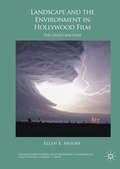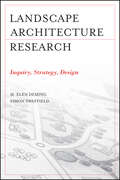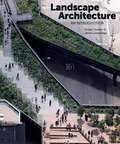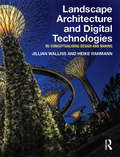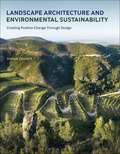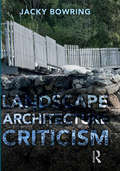- Table View
- List View
Landscape and the Environment in Hollywood Film: The Green Machine
by Ellen E. MooreThis book systematically explores how popular Hollywood film portrays environmental issues through various genres. In so doing, it reveals the influence exerted by media consolidation and the drive for profit on Hollywood’s portrayal of the natural landscape, which ultimately shapes how environmental problems and their solutions are presented to audiences. Analysis is framed by a consideration of how cultural studies can make more theoretical and practical room for environmental concern, thereby expanding its capacity for critical examination. The book begins by introducing the theoretical underpinning of the research as it relates to cultural studies, landscape, and genre. In the chapters that follow, each genre is taken in turn, starting with popular animated family films and progressing through spy thrillers, eco-thrillers, science fiction, Westerns, superhero films, and drama. This book is ideal for students and scholars in a variety of disciplines, including film, environmental studies, communication, political economy, and cultural studies.
Landscape and the Environment in Hollywood Film: The Green Machine
by Ellen E. MooreThis book systematically explores how popular Hollywood film portrays environmental issues through various genres. In so doing, it reveals the influence exerted by media consolidation and the drive for profit on Hollywood’s portrayal of the natural landscape, which ultimately shapes how environmental problems and their solutions are presented to audiences. Analysis is framed by a consideration of how cultural studies can make more theoretical and practical room for environmental concern, thereby expanding its capacity for critical examination. The book begins by introducing the theoretical underpinning of the research as it relates to cultural studies, landscape, and genre. In the chapters that follow, each genre is taken in turn, starting with popular animated family films and progressing through spy thrillers, eco-thrillers, science fiction, Westerns, superhero films, and drama. This book is ideal for students and scholars in a variety of disciplines, including film, environmental studies, communication, political economy, and cultural studies.
Landscape and the Environment in Hollywood Film: The Green Machine
by Ellen E. MooreThis book systematically explores how popular Hollywood film portrays environmental issues through various genres. In so doing, it reveals the influence exerted by media consolidation and the drive for profit on Hollywood’s portrayal of the natural landscape, which ultimately shapes how environmental problems and their solutions are presented to audiences. Analysis is framed by a consideration of how cultural studies can make more theoretical and practical room for environmental concern, thereby expanding its capacity for critical examination. The book begins by introducing the theoretical underpinning of the research as it relates to cultural studies, landscape, and genre. In the chapters that follow, each genre is taken in turn, starting with popular animated family films and progressing through spy thrillers, eco-thrillers, science fiction, Westerns, superhero films, and drama. This book is ideal for students and scholars in a variety of disciplines, including film, environmental studies, communication, political economy, and cultural studies.
Landscape and Urban Design for Health and Well-Being: Using Healing, Sensory and Therapeutic Gardens
by Gayle Souter-BrownIn this book Gayle Souter-Brown explores the social, economic and environmental benefits of developing greenspace for health and well-being. She examines the evidence behind the positive effects of designed landscapes, and explains effective methods and approaches which can be put into practice by those seeking to reduce costs and add value through outdoor spaces. Using principles from sensory, therapeutic and healing gardens, Souter-Brown focuses on landscape’s ability to affect health, education and economic outcomes. Already valued within healthcare environments, these design guidelines for public and private spaces extend the benefits throughout our towns and cities. Covering design for school grounds to public parks, public housing to gardens for stressed executives, this richly illustrated text builds the case to justify inclusion of a designed outdoor area in project budgets. With case studies from the US, UK, Africa, Asia, Australasia and Europe, it is an international, inspirational and valuable tool for those interested in landscapes that provide real benefits to their users.
Landscape and Urban Design for Health and Well-Being: Using Healing, Sensory and Therapeutic Gardens
by Gayle Souter-BrownIn this book Gayle Souter-Brown explores the social, economic and environmental benefits of developing greenspace for health and well-being. She examines the evidence behind the positive effects of designed landscapes, and explains effective methods and approaches which can be put into practice by those seeking to reduce costs and add value through outdoor spaces. Using principles from sensory, therapeutic and healing gardens, Souter-Brown focuses on landscape’s ability to affect health, education and economic outcomes. Already valued within healthcare environments, these design guidelines for public and private spaces extend the benefits throughout our towns and cities. Covering design for school grounds to public parks, public housing to gardens for stressed executives, this richly illustrated text builds the case to justify inclusion of a designed outdoor area in project budgets. With case studies from the US, UK, Africa, Asia, Australasia and Europe, it is an international, inspirational and valuable tool for those interested in landscapes that provide real benefits to their users.
Landscape and Utopia (Routledge Research in Landscape and Environmental Design)
by Jody BeckThis book examines three landmark utopian visions central to 20th century landscape architectural, planning, and architectural theory. The period between the 1890s and the 1940s was a fertile time for utopian thinking. Significant geographic shifts of large populations; radically altered relations between capital and labor; rapid technological developments; large investments in transportation and energy infrastructure; and repetitive economic disruptions motivated many individuals to wholly reimagine society – including the connections between social relations and the built environment. Landscape and Utopia examines the role of landscapes in the political imaginations of the Garden City, the Radiant City, and Broadacre City. Each project uses landscapes to propose a reconstruction of the relationships between land, labor, and capital but - while the projects are well-known – the role played by landscapes has been largely left unexamined. Similarly, the radical anti-capitalism that underpinned each project has similarly been, for the most part, left out of contemporary discussions. This book sets these projects within a historical and philosophical context and opens a discussion on the role of landscapes in society today. This book will be a must-read for instructors, students, and researchers of the history and theory of landscape architecture, planning, and architecture as well as utopian studies, cultural and social history, and environmental theory.
Landscape and Utopia (Routledge Research in Landscape and Environmental Design)
by Jody BeckThis book examines three landmark utopian visions central to 20th century landscape architectural, planning, and architectural theory. The period between the 1890s and the 1940s was a fertile time for utopian thinking. Significant geographic shifts of large populations; radically altered relations between capital and labor; rapid technological developments; large investments in transportation and energy infrastructure; and repetitive economic disruptions motivated many individuals to wholly reimagine society – including the connections between social relations and the built environment. Landscape and Utopia examines the role of landscapes in the political imaginations of the Garden City, the Radiant City, and Broadacre City. Each project uses landscapes to propose a reconstruction of the relationships between land, labor, and capital but - while the projects are well-known – the role played by landscapes has been largely left unexamined. Similarly, the radical anti-capitalism that underpinned each project has similarly been, for the most part, left out of contemporary discussions. This book sets these projects within a historical and philosophical context and opens a discussion on the role of landscapes in society today. This book will be a must-read for instructors, students, and researchers of the history and theory of landscape architecture, planning, and architecture as well as utopian studies, cultural and social history, and environmental theory.
Landscape Architect's Pocket Book (Routledge Pocket Books)
by Siobhan Vernon Susan Irwine Joanna Patton Neil ChapmanThis third edition of the bestselling Landscape Architect’s Pocket Book, written by leading practitioners, incorporates updates and revisions to environmental and building regulations, contracts, and a range of design guidelines including materials, SuDS, environmental impact, and landscape character assessment. The book is an indispensable tool for all landscape architects, providing a timesaving guide and first point of reference to everyday topics, both out on site and in the office. The pocket book covers all major subjects, including hard and soft landscaping, national guidelines and standards, and key planning policy and legislation. Providing concise, easy-to-read reference material, useful calculations, and instant access to a wide range of topics, it is an essential resource for landscape architects, construction industry professionals, and students.
Landscape Architect's Pocket Book (Routledge Pocket Books)
by Siobhan Vernon Susan Irwine Joanna Patton Neil ChapmanThis third edition of the bestselling Landscape Architect’s Pocket Book, written by leading practitioners, incorporates updates and revisions to environmental and building regulations, contracts, and a range of design guidelines including materials, SuDS, environmental impact, and landscape character assessment. The book is an indispensable tool for all landscape architects, providing a timesaving guide and first point of reference to everyday topics, both out on site and in the office. The pocket book covers all major subjects, including hard and soft landscaping, national guidelines and standards, and key planning policy and legislation. Providing concise, easy-to-read reference material, useful calculations, and instant access to a wide range of topics, it is an essential resource for landscape architects, construction industry professionals, and students.
Landscape Architect's Pocket Book (Routledge Pocket Books)
by Siobhan Vernon Rachel Tennant Nicola GarmoryAn indispensable tool for all landscape architects, this time-saving guide answers the most frequently asked questions in one pocket-sized volume. It is a concise, easy-to-read reference that gives instant access to a wide range of information needed on a daily basis, both out on site and in the office.Covering all the major topics, including hard landscaping, soft landscaping as well as planning and legislation, the pocket book also includes a handy glossary of important terms, useful calculations and helpful contacts. Not only an essential tool for everyday queries on British standards and procedures, this is a first point of reference for those seeking more extensive, supplementary sources of information, including websites and further publications. This new edition incorporates updates and revisions from key planning and environmental legislation, guidelines and national standards.
Landscape Architect's Pocket Book (Routledge Pocket Books)
by Siobhan Vernon Rachel Tennant Nicola GarmoryAn indispensable tool for all landscape architects, this time-saving guide answers the most frequently asked questions in one pocket-sized volume. It is a concise, easy-to-read reference that gives instant access to a wide range of information needed on a daily basis, both out on site and in the office.Covering all the major topics, including hard landscaping, soft landscaping as well as planning and legislation, the pocket book also includes a handy glossary of important terms, useful calculations and helpful contacts. Not only an essential tool for everyday queries on British standards and procedures, this is a first point of reference for those seeking more extensive, supplementary sources of information, including websites and further publications. This new edition incorporates updates and revisions from key planning and environmental legislation, guidelines and national standards.
Landscape Architectural Graphic Standards (Ramsey/Sleeper Architectural Graphic Standards Series #27)
by Leonard J. HopperThe new student edition of the definitive reference on landscape architecture Landscape Architectural Graphic Standards, Student Edition is a condensed treatment of the authoritative Landscape Architectural Graphic Standards, Professional Edition. Designed to give students the critical information they require, this is an essential reference for anyone studying landscape architecture and design. Formatted to meet the serious student's needs, the content in this Student Edition reflects topics covered in accredited landscape architectural programs, making it an excellent choice for a required text in landscape architecture, landscape design, horticulture, architecture, and planning and urban design programs. Students will gain an understanding of all the critical material they need for the core classes required by all curriculums, including: * Construction documentation * Site planning * Professional practice * Site grading and earthwork * Construction principles * Water supply and management * Pavement and structures in the landscape * Parks and recreational spaces * Soils, asphalt, concrete, masonry, metals, wood, and recreational surfaces * Evaluating the environmental and human health impacts of materials Like Landscape Architectural Graphic Standards, this Student Edition provides essential specification and detailing information on the fundamentals of landscape architecture, including sustainable design principles, planting (including green roofs), stormwater management, and wetlands constuction and evaluation. In addition, expert advice guides readers through important considerations such as material life cycle analysis, environmental impacts, site security, hazard control, environmental restoration and remediation, and accessibility. Visit the Companion web site: wiley.com/go/landscapearchitecturalgraphicstandards
Landscape Architectural Research: Inquiry, Strategy, Design
by M. Elen Deming Simon SwaffieldA practical, single-source guide tosuccessful strategies for landscape architecture research As the scope of landscape architecture expands to engage with other disciplines, and streams of information directing this field continue to grow and diversify, it becomes increasingly important for landscape architects to be able to implement a range of effective research strategies when seeking, creating, and validating knowledge. Landscape Architecture Research offers a framework for advancing better design thinking solutions by supplying readers with a system of inquiry tactics that open up a wider range of research possibilities. With a logical and innovative approach that favors legitimacy of knowledge based on collective, grounded practices, rather than strict adherence to protocols drawn only from scientific models, this comprehensive, illustrated guide produces a sound argument for establishing a new paradigm for legitimizing research quality. Landscape Architecture Research presents: Case studies that show how the range of presented research strategies have been successfully used in practice New perspective on the relationship between theory, research, practice, and critique, a relationship that is specific to landscape architecture Detailed coverage of the ways that new knowledge is produced through research activities and practical innovations in landscape architecture The first and only book on this topic of growing importance in landscape architecture, Landscape Architecture Research keeps professionals and students in step with the latest developments in landscape architecture, and delivers a dynamic and flexible game plan for verifying the integrity of their work.
Landscape Architectural Research: Inquiry, Strategy, Design
by M. Elen Deming Simon SwaffieldA practical, single-source guide tosuccessful strategies for landscape architecture research As the scope of landscape architecture expands to engage with other disciplines, and streams of information directing this field continue to grow and diversify, it becomes increasingly important for landscape architects to be able to implement a range of effective research strategies when seeking, creating, and validating knowledge. Landscape Architecture Research offers a framework for advancing better design thinking solutions by supplying readers with a system of inquiry tactics that open up a wider range of research possibilities. With a logical and innovative approach that favors legitimacy of knowledge based on collective, grounded practices, rather than strict adherence to protocols drawn only from scientific models, this comprehensive, illustrated guide produces a sound argument for establishing a new paradigm for legitimizing research quality. Landscape Architecture Research presents: Case studies that show how the range of presented research strategies have been successfully used in practice New perspective on the relationship between theory, research, practice, and critique, a relationship that is specific to landscape architecture Detailed coverage of the ways that new knowledge is produced through research activities and practical innovations in landscape architecture The first and only book on this topic of growing importance in landscape architecture, Landscape Architecture Research keeps professionals and students in step with the latest developments in landscape architecture, and delivers a dynamic and flexible game plan for verifying the integrity of their work.
Landscape Architecture: An Introduction
by Jamie Liversedge Robert HoldenAimed at prospective and new students, this book gives a comprehensive introduction to the nature and practice of landscape architecture, the professional skills required and the latest developments.After discussing the history of the profession, the book explains the design process through principles such as hierarchy, human scale, unity, harmony, asymmetry, colour, form and texture. It looks at how design is represented through both drawing and modelling, and through digital techniques such as CAD and the use of GIS (Geographic Information Systems). This is followed by an examination of project management and landscape management techniques. Finally, the book explores educational and employment opportunities and the future of the profession in the context of climate change and sustainability.Illustrated with international examples of completed projects, Landscape Architecture provides an invaluable, one-stop resource for anyone considering studying or a career in this field.
Landscape Architecture and Digital Technologies: Re-conceptualising design and making
by Jillian Walliss Heike RahmannLandscape Architecture and Digital Technologies explores how digital technologies are reshaping design and making in landscape architecture. While the potentials of digital technologies are well documented within landscape planning and visualisation, their application within design practice is far less understood. This book highlights the role of the digital model in encouraging a new design logic that moves from the privileging of the visual to a focus on processes of formation, bridging the interface of the conceptual and material, the virtual and the physical. Drawing on interviews and projects from a range of international designers -including , Snøhetta, Arup, Gustafson Porter, ASPECT Studios, Grant Associates, Catherine Mosbach, Philippe Rahm, PARKKIM, LAAC and PEG office of landscape + architecture among others, the authors explore the influence of parametric modelling, scripting, real-time data, simulation, prototyping, fabrication, and Building Information Modelling on the design and construction of contemporary landscapes. This engagement with practice is expanded through critical reflection from academics involved in landscape architecture programs around the world that are reshaping their research and pedagogy to reflect an expanded digital realm. Crossing critical theory, technology and contemporary design, the book constructs a picture of an emerging twenty-first century practice of landscape architecture practice premised on complexity and performance. It also highlights the disciplinary demands and challenges in engaging with a rapidly evolving digital context within practice and education. The book is of immense value to professionals and researchers, and is a key publication for digital landscape courses at all levels.
Landscape Architecture and Digital Technologies: Re-conceptualising design and making
by Jillian Walliss Heike RahmannLandscape Architecture and Digital Technologies explores how digital technologies are reshaping design and making in landscape architecture. While the potentials of digital technologies are well documented within landscape planning and visualisation, their application within design practice is far less understood. This book highlights the role of the digital model in encouraging a new design logic that moves from the privileging of the visual to a focus on processes of formation, bridging the interface of the conceptual and material, the virtual and the physical. Drawing on interviews and projects from a range of international designers -including , Snøhetta, Arup, Gustafson Porter, ASPECT Studios, Grant Associates, Catherine Mosbach, Philippe Rahm, PARKKIM, LAAC and PEG office of landscape + architecture among others, the authors explore the influence of parametric modelling, scripting, real-time data, simulation, prototyping, fabrication, and Building Information Modelling on the design and construction of contemporary landscapes. This engagement with practice is expanded through critical reflection from academics involved in landscape architecture programs around the world that are reshaping their research and pedagogy to reflect an expanded digital realm. Crossing critical theory, technology and contemporary design, the book constructs a picture of an emerging twenty-first century practice of landscape architecture practice premised on complexity and performance. It also highlights the disciplinary demands and challenges in engaging with a rapidly evolving digital context within practice and education. The book is of immense value to professionals and researchers, and is a key publication for digital landscape courses at all levels.
Landscape Architecture and Environmental Sustainability: Creating Positive Change Through Design (Required Reading Range)
by Joshua ZeunertWinner of the Australian Institute of Landscape Architects (AILA) National Excellence Award (Research and Communication) 2017Winner of the AILA VIC Excellence Award (Research and Communication) 2017Highly Commended (Communication and Presentation) Landscape Institute Awards 2018Landscape architecture has a pivotal role in ensuring environmental sustainability through design interventions. This book takes a broad look at strategies and completed projects to provide the reader with a strong understanding of the sustainability challenges being faced by designers today, and potential routes to addressing them. The book covers essential concepts of landscape architecture and environmental sustainability, including: - Ecology, multifunctional landscapes and sensitive intervention- Remediation, cleansing and environmental infrastructure- Social sustainability, design activism and healthy landscapes - Food systems, productive landscapes and transportation- Performance ratings, materials and life cycles Through case studies from around the world and interviews with leading landscape architects and practitioners, this book invites discussion about possible future scenarios, relevant theories and project responses in landscape environmental design. With hundreds of color images throughout the book, and additional study material in the companion website, Joshua Zeunert provides an overview of the multidimensional qualities of landscape sustainability.
Landscape Architecture as Storytelling: Learning Design Through Analogy
by Bob ScarfoThis book introduces students, practitioners, and laypeople to a comfortable approach to learning landscape architectural design free of design jargon and derived from their existing knowledge. A step-by-step process has readers consider their knowledge of language as metaphorically related to basic design and landscape design. Through information delivery and questioning processes, readers build on what they already know, their tacit understanding of language as applied to problem solving and storytelling. Everyone is a storyteller. Taken one step at a time through a three-tiered analogy of language, basic design, and landscape design, readers learn the makeup and role of such design features as points, lines, planes, volumes and sequential volumetric spaces that make up their worlds. With that, in a sense, new world view, and numerous questions and examples, readers begin to see that they in fact daily read the environments in which they live, work, play, raise families, and grow old. Once they realize how they read their surroundings they are helped to recognize that they can build narratives into their surroundings. At that point the existence of authored landscape narratives finds readers understanding a design process that relies on the designer-as-author, landscape-as-text, and participant, user-as-reader. That process has the reader write a first- or second-person narrative, visually interpret the written narrative into a storyboard, and turn the storyboard into a final design, the physical makeup of which is read by those who participate in it.
Landscape Architecture as Storytelling: Learning Design Through Analogy
by Bob ScarfoThis book introduces students, practitioners, and laypeople to a comfortable approach to learning landscape architectural design free of design jargon and derived from their existing knowledge. A step-by-step process has readers consider their knowledge of language as metaphorically related to basic design and landscape design. Through information delivery and questioning processes, readers build on what they already know, their tacit understanding of language as applied to problem solving and storytelling. Everyone is a storyteller. Taken one step at a time through a three-tiered analogy of language, basic design, and landscape design, readers learn the makeup and role of such design features as points, lines, planes, volumes and sequential volumetric spaces that make up their worlds. With that, in a sense, new world view, and numerous questions and examples, readers begin to see that they in fact daily read the environments in which they live, work, play, raise families, and grow old. Once they realize how they read their surroundings they are helped to recognize that they can build narratives into their surroundings. At that point the existence of authored landscape narratives finds readers understanding a design process that relies on the designer-as-author, landscape-as-text, and participant, user-as-reader. That process has the reader write a first- or second-person narrative, visually interpret the written narrative into a storyboard, and turn the storyboard into a final design, the physical makeup of which is read by those who participate in it.
Landscape Architecture Criticism
by Jacky BowringLandscape Architecture Criticism offers techniques, perspectives and theories which relate to landscape architecture, a field very different from the more well-known domains of art and architectural criticism. Throughout the book, Bowring delves into questions such as, how do we know if built or unbuilt works of landscape architecture are successful? What strategies are used to measure the success or failure, and by whom? Does design criticism only come in written form? It brings together diverse perspectives on criticism in landscape architecture, establishing a substantial point of reference for approaching design critique, exploring how criticism developed within the discipline. Beginning with an introductory overview to set the framework, the book then moves on to historical perspectives, the purpose of critique, theoretical positions ranging from aesthetics, to politics and experience, unbuilt projects, techniques, and communication. Written for professionals and academics, as well as for students and instructors in landscape architecture, it includes strategies, diagrams, matrices, and full colour illustrations to prompt discussion and provide a basis for exploring design critique.
Landscape Architecture Criticism
by Jacky BowringLandscape Architecture Criticism offers techniques, perspectives and theories which relate to landscape architecture, a field very different from the more well-known domains of art and architectural criticism. Throughout the book, Bowring delves into questions such as, how do we know if built or unbuilt works of landscape architecture are successful? What strategies are used to measure the success or failure, and by whom? Does design criticism only come in written form? It brings together diverse perspectives on criticism in landscape architecture, establishing a substantial point of reference for approaching design critique, exploring how criticism developed within the discipline. Beginning with an introductory overview to set the framework, the book then moves on to historical perspectives, the purpose of critique, theoretical positions ranging from aesthetics, to politics and experience, unbuilt projects, techniques, and communication. Written for professionals and academics, as well as for students and instructors in landscape architecture, it includes strategies, diagrams, matrices, and full colour illustrations to prompt discussion and provide a basis for exploring design critique.
Landscape Architecture Documentation Standards: Principles, Guidelines, and Best Practices
by Design WorkshopSUPERB EXECUTION RELIES UPON RIGOROUS PROJECT DOCUMENTATION A project will only be built as well as it is documented. This publication focuses on the key documentation needs of the landscape architectural design and construction documentation process. That includes both "design documentation" and "construction documentation" as well as all that which occurs in the transition from one phase to the other. Documentation requirements include those components necessary to explore and define design intent, logic, physical proposals, and ultimately, the specific components included within construction and bid documents. Discover how proper documentation facilitates every stage of the design process from pre-planning to construction, and leads to a highly resolved built outcome. Understand the principles behind these documentation practices. Implement best practices specific to each documentation phase and drawing, from title block and cover sheet design to soil plans and plant protection. Organize keynoting systems, cross-referencing and interdisciplinary coordination amongst multiple consultants and vendors. Study sample project documents from a leading landscape architecture firm to better understand the elements and benefits of complete and well-coordinated project documentation. These standards have been time-tested by over 150 designers at the industry leading landscape architecture firm Design Workshop, reflecting a range of project types, including parks, streetscapes, urban spaces and over-structure construction. This guide shares the methods behind the success, to facilitate exceptional built outcomes through principled documentation practices.
Landscape Architecture Documentation Standards: Principles, Guidelines, and Best Practices
by Design WorkshopSUPERB EXECUTION RELIES UPON RIGOROUS PROJECT DOCUMENTATION A project will only be built as well as it is documented. This publication focuses on the key documentation needs of the landscape architectural design and construction documentation process. That includes both "design documentation" and "construction documentation" as well as all that which occurs in the transition from one phase to the other. Documentation requirements include those components necessary to explore and define design intent, logic, physical proposals, and ultimately, the specific components included within construction and bid documents. Discover how proper documentation facilitates every stage of the design process from pre-planning to construction, and leads to a highly resolved built outcome. Understand the principles behind these documentation practices. Implement best practices specific to each documentation phase and drawing, from title block and cover sheet design to soil plans and plant protection. Organize keynoting systems, cross-referencing and interdisciplinary coordination amongst multiple consultants and vendors. Study sample project documents from a leading landscape architecture firm to better understand the elements and benefits of complete and well-coordinated project documentation. These standards have been time-tested by over 150 designers at the industry leading landscape architecture firm Design Workshop, reflecting a range of project types, including parks, streetscapes, urban spaces and over-structure construction. This guide shares the methods behind the success, to facilitate exceptional built outcomes through principled documentation practices.
Landscape Architecture for Sea Level Rise: Innovative Global Solutions
by Galen D. Newman Zixu QiaoThis book assesses and illustrates innovative and practical world-wide measures for combating sea level rise from the profession of landscape architecture. The work explores how the appropriate mixture of integrated, multi-scalar flood protection mechanisms can reduce risks associated with flood events including sea level rise. Because sea level rise is a global issue, illustrative case studies performed from the United States, Korea, Australia, New Zealand, Thailand, Japan, China, and the Netherlands identify the structural (engineered), non-structural (nature-based), and hybrid mechanisms (mixed) used to combat sea level rise and increase flood resilience. The alternative flood risk reduction mechanisms are extracted and analyzed from each case study to develop and explain a set of design-based typologies to combat sea level rise which can then be applied to help proctor new and existing communities. It is important for those located within the current or future floodplain considering sea level rise and those responsible for land use, developmental, and population-related activities within these areas to strategically implement a series of integrated constructed and green infrastructure-based flood risk reduction mechanisms to adequately protect threatened areas. As a result, this book is beneficial to both academics and practitioners related to multiple design professions such as urban designers, urban planners, architects, real estate developers, and landscape architects.
